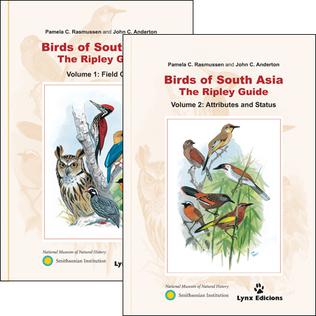List of species
Species endemic to India
Species endemic to the Western Ghats and associated hills



- Nilgiri woodpigeon
- Malabar imperial pigeon
- Malabar parakeet
- Malabar grey hornbill
- Malabar flameback
- Malabar barbet
- Nilgiri flowerpecker
- Crimson-backed sunbird
- Nilgiri pipit
- Malabar lark
- Grey-headed bulbul
- Flame-throated bulbul
- Rufous babbler
- Banasura laughingthrush
- Nilgiri laughingthrush
- Palani laughingthrush
- Ashambu laughingthrush
- Vigors's sunbird
- White-bellied blue flycatcher
- Black-and-orange flycatcher
- Nilgiri flycatcher
- White-bellied blue robin
- Nilgiri blue robin
- Nilgiri thrush
- Broad-tailed grassbird
- Malabar white-headed starling
- Malabar woodshrike (Tephrodornis sylvicola)
- Square-tailed black bulbul (Hypsipetes ganeesa)
Other localised species endemic to peninsular India

- Grey junglefowl
- Rock bush-quail
- Jerdon's courser
- Forest owlet
- Mottled wood-owl
- Malabar trogon (forests)
- White-cheeked barbet
- White-spotted fantail
- Indian black-lored tit
- Yellow-throated bulbul
- Indian scimitar babbler (forests only)
- Tickell's blue flycatcher
- Malabar whistling-thrush (forests only)
- Sykes's lark
Species endemic to Sri Lanka


- Sri Lanka spurfowl
- Sri Lanka junglefowl
- Layard's parakeet
- Sri Lanka wood-pigeon
- Sri Lanka hanging parrot
- Green-billed coucal
- Red-faced malkoha
- Sri Lanka grey hornbill
- Black-crested bulbul
- Yellow-eared bulbul
- Yellow-fronted barbet
- Crimson-fronted barbet
- White-throated flowerpecker
- Sri Lanka white-eye
- Sri Lanka blue magpie
- Sri Lanka whistling thrush
- Spot-winged thrush
- Sri Lanka scaly thrush (Zoothera dauma imbricata)
- Ashy-headed laughingthrush
- White-faced starling
- Brown-capped babbler
- Orange-billed babbler
- Sri Lanka scimitar babbler (Pomatorhinus melanurus)
- Sri Lanka bush warbler
- Dull-blue flycatcher
- Sri Lanka myna
- Serendib scops-owl
- Chestnut-backed owlet
Other localised species endemic to peninsular India and Sri Lanka combined
- Blue-faced malkoha
- Sirkeer malkoha
- Common hawk-cuckoo
- Yellow-wattled lapwing
- Indian scops-owl
- Jungle owlet
- Malabar pied hornbill
- Brown-capped pygmy woodpecker
- Yellow-crowned woodpecker
- Black-rumped flameback
- Plum-headed parakeet
- Jungle nightjar
- Jerdon's nightjar
- Malabar trogon
- Malabar pied hornbill
- Bay-backed shrike
- White-bellied drongo
- White-bellied treepie
- Indian jungle crow
Species endemic to Sri Lanka and the Western Ghats combined
- Sri Lanka bay owl (Phodilus assimilis)
- Sri Lanka frogmouth
- Indian swiftlet
Other species endemic to the subcontinent




- Painted francolin
- Painted bush-quail
- Red spurfowl
- Painted spurfowl
- Indian peafowl
- Indian black ibis
- Crested hawk-eagle
- Indian vulture
- Lesser florican
- Indian bustard
- Indian courser
- Yellow-wattled lapwing
- Painted sandgrouse
- Plum-headed parakeet
- Grey-bellied cuckoo
- Common hawk-cuckoo
- Sirkeer malkoha
- Indian eagle-owl
- Mottled wood-owl
- Indian scops-owl
- Indian jungle nightjar
- Indian white-rumped spinetail
- Indian grey hornbill
- Brown-headed barbet
- Brown-capped pygmy woodpecker
- Black-rumped flameback
- White-naped flameback
- Indian pitta
- Indian bushlark
- Jerdon's bushlark
- Bengal bushlark
- Ashy-crowned finch-lark
- Rufous-tailed lark
- Sykes's lark
- Red-rumped swallow (Hirundo daurica hyperythra)
- White-browed wagtail
- Black-headed cuckoo-shrike
- White-bellied minivet
- Orange minivet
- Malabar woodshrike (Tephrodornis gularis sylvicola)
- Sri Lanka woodshrike (Tephrodornis pondicerianus affinis)
- White-spotted fantail (Rhipidura albicollis albogularis)
- Purple-rumped sunbird
Species endemic to northern parts of the subcontinent

- Swamp francolin
- Chestnut-breasted hill-partridge
- Himalayan quail
- Manipur bush-quail
- Jungle bush-quail
- Rock bush-quail
- Western tragopan
- Cheer pheasant
- Himalayan parakeet
- Brown-fronted woodpecker
- Himalayan woodpecker
- Himalayan black-lored tit (Machlolophus xanthogenys)
Near-endemics and seasonal endemics
In addition, the following species are near-endemics i.e. only a small proportion of the population is found outside the subcontinent:

- Pink-headed duck
- Grey francolin
- Satyr tragopan
- Himalayan monal
- White-bellied heron
- Indian spotted eagle
- Laggar falcon
- Yellow-rumped honeyguide
- Fulvous-breasted woodpecker
- Sind woodpecker
- Scaly-bellied woodpecker
The following species is endemic as a breeding species, but winters elsewhere:

